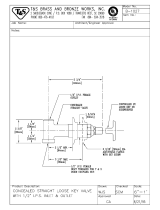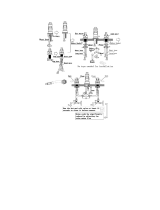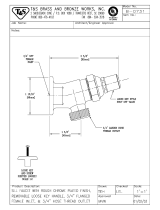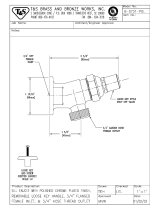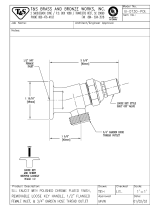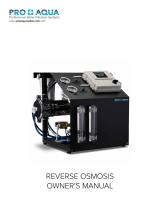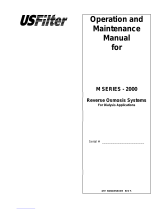Page is loading ...

GE OSMONICS
F-801 INTERNAL REVERSE OSMOSIS UNIT
Operation
and Maintenance Manual
Revision E
This Revision Supersedes P/n 12552 Rev. D


12552e
A
A 27 February 2004
F-801 INTERNAL REVERSE OSMOSIS UNIT
Installation, Operation and Maintenance Manual
TABLE OF CONTENTS
Page
CHAPTER ONE: GENERAL INFORMATION 1-1
Section 1.1 The Manual 1-3
1.2 Safety Summary 1-3
1.3 Applications 1-4
1.4 Contraindications 1-4
1.5 Environmental Considerations 1-5
1.6 Theory of Operation 1-6
1.7 Fluid Components 1-7
1.8 Monitors and Controls 1-9
1.9 Optional Equipment 1-11
1.10
1.10.1
1.10.2
1.10.3
1.10.4
1.10.5
Specifications
Inlet Water Requirements
Flow Rates
Electrical Requirements
Membrane Performance Characteristics
Environmental Requirements
1-12
1.11 Disposal 1-13
1.12 Electromagnetic Interference 1-13
1.13 Service Assistance 1-14
1.14 Return Goods Authorization (RGA) 1-15
1.15 Symbols and Abbreviations 1-16
CHAPTER TWO: INSTALLATION GUIDELINES AND INITIAL
SYSTEM START UP
2-1
Section 2.1 Installation Considerations 2-3
2.2 Installation Procedure 2-3
2.3 Product Water Analysis Procedure 2-5
CHAPTER THREE: SYSTEM OPERATION 3-1
Section 3.1 Daily Start-up Procedure 3-3
3.2 Bicarbonate Container Filling 3-6
3.3 Shut Down Procedure 3-6

12552e
B
B 27 February 2004
CHAPTER FOUR: ROUTINE MAINTENANCE 4-1
Section 4.1
4.1.1
Routine Maintenance of F-801 Internal RO
System
Daily / Per Treatment Maintenance
4-3
4-3
4.1.2 Weekly Maintenance 4-5
4.1.3 Monthly Maintenance 4-5
4.1.4 Quarterly Maintenance 4-6
4.1.5 Annual Maintenance 4-6
4.2
4.2.1
Specific Maintenance Procedures and Instructions
Motor Lubricant Procedure
4-7
4-7
4.2.2 Leak Repair 4-7
4.2.3 Pre-filter Replacement 4-9
4.3 F-801 Cleaning Indications 4-11
4.3.1 Pre-Cleaning Preparation 4-12
4.3.1.1 Pre-Cleaning Procedure 4-12
4.3.1.2 Cleaner Recirculation and Dwell Time 4-13
4.3.1.3 Post-Cleaning Rinse Procedure 4-14
4.3.2 BIOSAN Pre Cleaning Preparation 4-16
4.3.2.1 BIOSAN Cleaning Procedure 4-16
4.3.2.2 BIOSAN Recirculation and Dwell Time 4-17
4.3.2.3 BIOSAN Post Cleaning Rinse Procedure 4-18
4.4 F-801 Disinfection Indications 4-20
4.4.1 Formaldehyde Disinfection Preparation 4-20
4.4.1.1 Formaldehyde Pre-Disinfection Procedure 4-21
4.4.1.2 Formaldehyde Disinfection and Dwell Time 4-22
4.4.1.3 Formaldehyde Post-Disinfection Rinse Procedure 4-23
4.4.2 “RENALIN®” Disinfection Procedure
(Peracetic Acid and Peroxide-Based Compounds
such as Renalin®, Minncare™, & Peracidin™)
4-24
4.4.2.1 “RENALIN®” Pre-Disinfection Preparation 4-25
4.4.2.2 “RENALIN®” Disinfection and Dwell Time 4-26
4.4.2.3 “RENALIN®” Post-Disinfection Rinse Procedure 4-28
4.5 Product Water Culture 4-29
4.5.1 Product Water Culture Procedure 4-30
4.6 System Storage 4-31
4.6.1 Formaldehyde Storage Procedure 4-31
4.6.2 BIOSAN Storage Procedure 4-32

12552e
C
C 27 February 2004
CHAPTER FIVE: TROUBLESHOOTING 5-1
Table of Content 5-3
Section 5.1 RO Fails to Run 5-5
5.2 RO Runs Intermittently 5-5
5.3 Motor Runs Hot 5-6
5.4 Low Pump Pressure 5-6
5.5 Pressure Gauge Vibrates Erratically 5-7
5.6 Excess Product Pressure (too high) 5-7
5.7 Product Flow Too Low 5-7
5.8 Product Flow Too High 5-8
5.9 Membrane Product Pressure Too Low 5-9
5.10 Leaks 5-9
5.11 Low Percent Rejection 5-9
5.12 Rejection Display Fluctuates 5-10
5.13 TDS Value High 5-10
5.14 RO Fails to Draw Disinfectant 5-11
5.15 RO Pump Leaks 5-12
CHAPTER SIX: DRAWINGS 6-1
CHAPTER SEVEN: SPARE PARTS LIST 7-1

12552e
D
D 27 February 2004
This page intentionally left blank

F-801 Internal RO System by GE Osmonics
12552e – 27 Feb 04 1 - 1 General Information
F-801 Internal RO System
CHAPTER ONE:
GENERAL INFORMATION

F-801 Internal RO System by GE Osmonics
12552e – 27 Feb 04 1 - 2 General Information
This page intentionally left blank.

F-801 Internal RO System by GE Osmonics
12552e – 27 Feb 04 1 - 3 General Information
1.1 The Manual
This manual has been prepared to provide the operator with information and
instructions regarding the installation, use, maintenance and troubleshooting of the GE
Osmonics F-801 Internal Reverse Osmosis System.
CAUTION:
When used as a medical device, Federal law restricts this device to sale by or on
the order of a physician. Per CFR 801.109 (b)(1).
The manual has been written in narrative form supplemented with schematics and
drawings for clarification. The operator can perform most procedures mentioned in
this manual. Any exceptions will be clearly identified by a qualifying statement.
1.2 Safety Summary
Words in BOLD CAPITAL letters are used to identify labels on the device and key
safety or qualifying statements. A list of all symbols and abbreviations is located at the
end of this chapter. See Technote 120 for a glossary of relevant terms.
This safety summary does not contain all of the safety statements in the manual. Other
safety statements are included within the manual text and are enhanced and defined as
follows:
NOTE:
Statements that provide further clarification.
CAUTION:
Statements identifying conditions or practices that could result in equipment or
other property damage.
WARNING:
Statements identifying conditions or practices that could result in personal injury
or loss of life.
READ THIS MANUAL:
Prior to operating or servicing this device, this manual must be read and understood.
Keep this and other associated manuals for future reference and for new operators or
qualified service personnel. A note sheet is provided at the end of each chapter for
operators to make notations that may be valuable to other users.
USE PROPER POWER CONNECTIONS:
Use proper wiring and connection methods to satisfy hospital electrical codes.
DO NOT REMOVE COVERS OR PANELS:
To avoid electrical shock hazard, do not remove covers or panels when power is
supplied to the device. Do not operate the device when covers or panels are removed.

F-801 Internal RO System by GE Osmonics
12552e – 27 Feb 04 1 - 4 General Information
USE PROPER WATER AND DRAIN CONNECTIONS:
Use proper water and drain connections to prevent contamination of the RO and danger
to the patient. To ease confusion, the Quick Disconnect (QD) fittings have been color-
coded. Both the male and female fittings are colored. The color coding is; Green =
FEED water, Red = WASTE water, White = PERMEATE (Product) water.
SHOCK HAZARD:
Connect this device to a proper ground connection in accordance with the National
Electrical Code. DO NOT under any circumstances remove the ground wire or ground
prong from any power plug. DO NOT use an extension cord with this equipment.
Keep the surface under the RO(s) free of liquids. Fix any leaks from the hemodialysis
unit promptly.
DEVICE LABELING:
Do not under any circumstances; remove any Caution, Warning or any other
descriptive labels from the devices until the conditions warranting the label are
eliminated.
DO NOT OPERATE IN A FLAMMABLE ATMOSPHERE:
To avoid fire or explosion, do not operate this device in an explosive environment or
near flammable anesthetics.
DO NOT TRY TO CATCH THE EQUIPMENT IF IT STARTS TO FALL OVER:
The overall assembly is weighty and can cause physical harm.
1.3 Applications
The F-801 Internal Reverse Osmosis (RO) System is designed to purify water by
forcing water through a semi-permeable RO membrane. Water purified by reverse
osmosis has had approximately 95% of the dissolved ions and approximately 99% of
most other contaminants removed. The quality of the purified water, referred to as
product water or permeate, depends on the quality of the feed water and normally is
equal to or exceeds AAMI standards. Such water is suitable for hemodialysis
applications.
1.4 Contraindications
WARNING:
GE Osmonics systems are not designed, sold, or intended for use in producing
water for injection
Furthermore, GE Osmonics systems are not intended to be used outside of the device
specifications and limitations, as outlined in this manual and other related materials.

F-801 Internal RO System by GE Osmonics
12552e – 27 Feb 04 1 - 5 General Information
1.5 Environmental Considerations
Prior to the installation of the F-801 RO System, it will be necessary to provide utilities
and create an environment suitable for the trouble free operation of the RO system and
its accessories.
POWER:
The F-801 operates on 115 VAC single-phase power. Histories of power failure,
power surges, and low line voltages should be noted and reported to the
manufacturer or their agent as they may create adverse conditions for the
operation of equipment.
WATER:
Reverse osmosis systems require a reliable water source. The F-801 RO needs a
minimum of 30-PSI pressure at a minimum flow of 1.6 gallons per minute. It is
important that water is flowing at the design flow rate when testing water pressure
rather than reading static pressure.
DRAIN:
A drain outlet is required by the RO system. The drain must have a minimum
capacity of 1.6 gallons per RO per minute of continuous flow for as long as and
as often as the RO is operating.
TEMPERATURE:
The F-801 RO is normally connected to a cold water supply. The performance
specifications of the RO are based on 77°F (25°C) feed temperature. Each degree
Fahrenheit the feed water temperature falls, the RO product flow decreases
approximately 1.5%, and each degree Celsius drop, the product flow is reduced
by 3% (See Technote 113 for the “Temperature Correction Factors” chart). In
climates where the winter water temperature drops significantly below 77°F it
may be necessary to temper (heat) the water.
WARNING:
The temperature of the tempered water should be monitored closely with a
thermometer as high temperatures can damage the RO membranes and possibly
harm the patient. Refer to the inlet water requirements (Section 1.10.1) for the
maximum operating temperature for the F-801 RO.
CAUTION:
It is necessary to keep the RO from freezing to prevent serious damage to the RO
unit.
NOISE:
The RO unit does not generate significant noise levels. Hard walls may reflect
noise and will make the RO seem louder.

F-801 Internal RO System by GE Osmonics
12552e – 27 Feb 04 1 - 6 General Information
WATER PURITY:
Plumbing materials can significantly contribute to the contamination of the water.
Metallic pipes (with the exception of 316 stainless steel) must be eliminated once
the purification process has begun. Schedule 40 or 80 PVC pipes, polypropylene,
PVDF, and other FDA recommended materials are suitable for most grades of
purified water. Care must also be exercised in the choice of a thread sealant.
Teflon tape is suitable for all threaded connections in this system.
WARNING:
Ordinary pipe dope must be avoided since it may leach objectionable and
potentially dangerous impurities into the water.
1.6 Theory of Operation
The F-801 Portable Reverse Osmosis system (RO) purifies a given feed water (by way
of reverse osmosis) for use in hemodialysis applications. The F-801 RO possesses
monitoring for pressure, product water quality and membrane performance (percent
rejection). The unit includes pre-filtration to remove particulates greater than 5
microns, which could clog orifices or damage components. The RO pump provides the
pressure required to push water through the RO membrane. The fluid controls provide
a means of managing flow rates and pressures. The following paragraphs detail the
function of these fluid control components, which are used within the RO.

F-801 Internal RO System by GE Osmonics
12552e – 27 Feb 04 1 - 7 General Information
1.7 Fluid Components
Pre-filter:
From the feed water, the fluid path flows through the softener (optional) on
through the carbon tank and then into the pre-filter, located in a blue housing
mounted on the side of the hemodialysis unit. It is a cartridge type filter with a
nominal filtration rating of five microns.
Pressure Adjust Regulator:
Used to adjust the product pressure. The pressure is displayed on the product
pressure gauge, on the front of the RO.
High-Pressure Pump:
Provides up to a 200 PSI boost of the inlet water to the Reverse Osmosis
Membrane Assembly (ROMA). The RO pump pressure is displayed on a 0 to
300 PSI gauge mounted outside the RO, below the product pressure gauge. The
pressure is factory set at 150 PSI.
Reverse Osmosis Membrane Assembly (ROMA):
One is included in the F-801 RO. A ROMA is an assembly that includes the
membrane housing, end caps, fittings, and a membrane. The thin film membrane
will produce 600 (±15%) gallons per day of product water, depending on
membrane condition and water temperature.
Waste Flow:
The Waste Flow is controlled by a length of 1/8" capillary tubing. The length of
the tube is factory determined to correctly govern the wastewater flow to drain.
CAUTION:
This tube must not be shortened.
Dialyze/Flush Valve:
The Dialyze/Flush Valve is used to flush the membrane surface of rejected
contaminants, and to accelerate the rinse out of cleaners or disinfectants from the
RO. Some pump noise (chattering) is normal in the flush position. The RO is in
"flush" from the full open (flush) to just before the fully closed (dialyze) position.
CAUTION:
Excessive “chattering” may be eliminated by slowly moving the valve from the
full flush position towards “DIALYZE”.
Product Recirculation Check Valve:
Prevents over-pressuring of the product supply. When the product pressure
exceeds the set point of the pressure regulator, the product recirculation check
valve opens. Excess product water is then recirculated back to the inlet water
flow.

F-801 Internal RO System by GE Osmonics
12552e – 27 Feb 04 1 - 8 General Information
Feed Port:
The Feed Port is a green colored quick-disconnection port for the introduction of
feed water to the RO. The port has a check valve that closes when there is no
hose connected to the fitting.
Product Port:
The Product Port is a white colored quick-disconnection port for the output of
purified product water. The port has a check valve that closes when there is no
hose connected to the fitting.
Waste Port:
The Waste Port is a red colored quick-disconnection port for the output of
concentrate or waste to the drain. The port has a check valve that closes when
there is no hose connected to the fitting.

F-801 Internal RO System by GE Osmonics
12552e – 27 Feb 04 1 - 9 General Information
1.8 Monitors and Controls
RO Power Switch:
The RO Power Switch is mounted on the back of the remote monitor module.
The switch is used to turn the F-801 RO unit on and off.
Inlet Water Sensor:
Monitors the quality of the inlet water. Inlet quality is compared to the outlet
(product) water quality and is displayed as "percent rejection" on the front panel.
Product Water Sensor:
The Product Water Sensor is used in conjunction with the inlet water sensor by
the percent-rejection circuitry to calculate the membrane rejection rate. The rate
of rejection is displayed from 70% - 99% in a 5 LED array on the front panel.
Total Dissolved Solids (TDS) Sensor:
Samples the product water quality via the sensor probe, and the final quality of the
product water is indicated on a digital display on the front panel as TDS in mg/L
and ppm. The monitor is temperature compensated to adjust the display value to
changing water temperature.
Pressure Adjust Regulator:
The Pressure Adjust Regulator inside the RO is used to set the maximum product
pressure needed to supply a dialysis machine. Adjusting this regulator will also
result in small adjustments in the pump pressure.
Pre and Post filter Pressure Gauges:
The Pre-filter pressure gauges are mounted on top of the pre-filter housing and
display the feed water pressure from zero to 100 PSI. The two gauges are used to
determine the feed water pressure and when compared against each other to
determine fouling of the filter (delta pressure).
Product Pressure Gauge:
The Product Pressure Gauge reads the product pressure from 0 to 100 PSI and is
located on the RO module right side panel. Product pressure will read zero (or
close to) when the product line is not connected to a dialysis unit and the product
hose is connected to the product fitting and the valve is open. The Fresenius
dialysis machine requires a minimum inlet pressure of 20 PSI.
Pump Pressure Gauge:
The Pump Pressure Gauge reads the pump pressure from 0 to 300 PSI and is
located on the RO module right side panel. It is used for monitoring during
operation and when adjusting the pump pressure, and is located on the front of the
RO.

F-801 Internal RO System by GE Osmonics
12552e – 27 Feb 04 1 - 10 General Information
Dialyze/Flush Valve:
The Dialyze/Flush Valve is a 1/4-turn ball valve. When in the dialyze mode, the
valve is in the closed position. When the valve is turned at any point towards
flush, the valve is open. The closer to the flush point, the more the valve is open.
When in flush, the valve bypasses the waste flow tube.
Percent Rejection Display:
The Percent Rejection Display is a 5 LED array that indicates how the RO
membranes are performing. The lights correspond to 99%, 95%, 90%, 85%, and
>70% rejection. The 99% light, when illuminated, indicates a need to evaluate
the RO system performance. RO units do not normally perform in excess of
99%; verify this reading with an independent meter and take corrective action if
indicated. Some RO membranes will achieve this level of performance under
optimum conditions.
Product Water Total Dissolved Solids (TDS) Display:
The Product Water Total Dissolved Solids (TDS) digital display indicates product
water purity in mg/L (ppm). It is temperature compensated to adjust the value of
the display with changing water temperature for better accuracy.
Less Than 0.5 mg/L Check System Lamp:
The Less Than 0.5 mg/L Check System lamp illuminates when the TDS reading is
0.5 mg/L or less. This indicates a need to evaluate the RO system performance.
RO units do not normally have this low product TDS. Verify this reading with an
independent meter and take corrective action if indicated.
NOTE:
RO membranes may achieve this level of performance under optimum conditions
(good feed water).
Alarm Set:
The Alarm Set switch allows the operator to set the TDS levels at which the alarm
will sound. The alarm should be set at twice the initial TDS reading. If the set
point is exceeded, an audible alarm will sound.
NOTE:
Choose the alarm set point that is closest to twice the initial installation TDS
reading.
Alarm Mute:
The Alarm Mute switch will mute the audible alarm for 30 - 45 seconds. A red
indicator lamp is displayed on the switch when the mute switch has been pressed.

F-801 Internal RO System by GE Osmonics
12552e – 27 Feb 04 1 - 11 General Information
1.9 Optional Equipment
GE Osmonics offers a number of optional items to adapt the equipment to meet specific
needs. Options are available to improve the quality of the feedwater to the RO.
Frequently requested options are briefly described in the following paragraphs. If more
information is needed, or if other options are desired, please consult the factory. Refer
to Chapter xx for catalog part numbers.
Carbon Filter Tanks remove chlorine/chloramine from the feed water, preventing
damage to the RO membrane and injury to patients. The filter incorporates a bed of
granular activated carbon. Two sizes of carbon tanks come in semi-automatic control
valve and exchange head styles.
WARNING:
Carbon is not regenerated and must be replaced when exhausted.
WARNING:
A suitable carbon filter should always be present as pretreatment for the RO unit
in order to prevent chlorine/chloramine damage to the thin film RO membrane
and harm to the patient. GE Osmonics strongly recommends the use of two
carbon tanks, used in a series configuration.
Softeners remove calcium, magnesium, and other scale producing contaminants from
the feed water. Their removal prevents the build-up of scale on the membrane surface.
A control valve drives the regeneration of the softener, and will remove the hardness
ions with a brine solution and rinse the ion exchange bed afterwards. The control valve
is normally governed by a semi-automatic time clock. There are two sizes of softener
tanks available.
Multi-Media Filter Tanks are a multi layered filtration system that consists of various
sized rocks as the media layers. The media are selected on the basis of their size and
specific gravities. Capable of removing ninety-eight percent of all particles greater than
ten microns, the multi-media filter is employed to remove suspended solids and
particulates from the water. The use of the multi-media filter will extend the life of the
pre-filter and RO membrane. Multi-media filters are not portable and not commonly
used with portable RO systems.
Dealkalizers are used to lower the pH of alkaline feed water. Water with pH levels
above 8.5 with chloramines present can reduce the performance of the carbon filters
and thin-film membranes. A control valve drives the regeneration rinsing of the
dealkalizer. The control valve is normally governed by a semi-automatic time clock.
There are two sizes of dealkalizer tanks available.

F-801 Internal RO System by GE Osmonics
12552e – 27 Feb 04 1 - 12 General Information
1.10 Specifications:
1.10.1 Input Water Requirements
Minimum
Maximum
Input flow Rate 2.0 GPM N/A
Temperature (water) 10°C (50°F) 32°C (90°F)
NOTE:
Operating at lower temperatures may make it impossible for the F-801 RO to
produce adequate permeate for the dialysis machine.
pH (operating) 5.5 10.5
TF Membranes
pH w/chloramines present (operating) 5.5 8.5
TF Membranes
pH (cleaning) 2.0 11.0
TF Membranes
Pressure, dynamic 30 PSI 100 PSI
1.10.2 Flow Rates
Product Flow based on the following conditions:
New Membranes
Operating Pressure: 150 PSI
Product Pressure: 1 PSI
Feed Water Temperature: 77°F (25°C)
GPM
LPM GPD LPD
.41 1.55 588 2225.8
Membrane flux may vary ±15%
Waste Flow: 2000ml/min (±10%)
1.10.3 Electrical Requirements
Motor 1/3 HP
Voltage 115 V~
Hertz 60
Amps 10
Phase single
Power Cord (length) 8 ft (2.4 m)

F-801 Internal RO System by GE Osmonics
12552e – 27 Feb 04 1 - 13 General Information
1.10.4 Membrane Performance Characteristics
Salt rejection (TF Membranes): 95% minimum at initial testing at factory.
Test Solution: Inlet water 1000 PPM NaCl
Conductivity: 2000 micro mhos-cm
Operating Pressure: 200 PSI
Product Back pressure: 0 PSI
1.10.5 Environmental Requirement
Minimum Maximum
Ambient Temperature 4°C (39°F) 32°C (90°F)
Storage Temperature 2°C (36°F) 32°C (90°F)
Altitude N/A 10,000 feet
CAUTION:
This equipment must not be allowed to freeze. Irreparable harm to various
components, including RO membranes may result.
NOTE:
The user/operator should recognize that moisture can be caused by condensation
and is not necessarily an equipment leak. This equipment will function in the
presence of condensation.
1.11 Disposal
Disposal of this product or parts must be carried out according with local disposal
codes.
1.12 Electromagnetic Interference
This equipment can generate, uses and can radiate radio frequency energy and, if not
installed and used in accordance with these instructions, may cause harmful
interference to other devices in the vicinity. However, there is no guarantee that
interference will not occur in a particular installation. If this equipment does cause
harmful interference with other devices, which can be determined by turning the
equipment off and on, the user is encouraged to try to correct the interference by one
or more of the following measures:
• Reorient or relocate the receiving device
• Increase the separation between the equipment
• Connect the equipment into an outlet on a circuit different from that to
which the other device(s) is connected
• Consult the field service technician or manufacturer for help.

F-801 Internal RO System by GE Osmonics
12552e – 27 Feb 04 1 - 14 General Information
1.13 Service Assistance
If service assistance is required, please take the following steps:
Consult the “Troubleshooting” section of this manual (Chapter Five). If the problem
cannot be identified and corrected by any of the procedures found in that section,
then...
Contact your Facility Equipment Technician. If the technician is unable to help then…
Call GE Osmonics Technical Service Department at (800) 633-3080 or (206) 395-2200.
Technicians are available for all calls between 7:00 a.m. and 4:30 p.m. PST, Monday
through Friday. Technicians are also available at other times for emergency calls
only. Product consultants will be on hand to discuss the problem with you and
endeavor to rectify it over the phone. If the problem appears to be of a more serious
nature, you will be given instructions regarding the action to be taken. Prior to making
the phone call, you must be prepared to answer two questions:
1. What RO do you have, i.e. F-801
2. What is the serial number of your RO? (Label, found on back of Remote
Monitor.)
RO SERIAL NUMBER: ______________________
/
